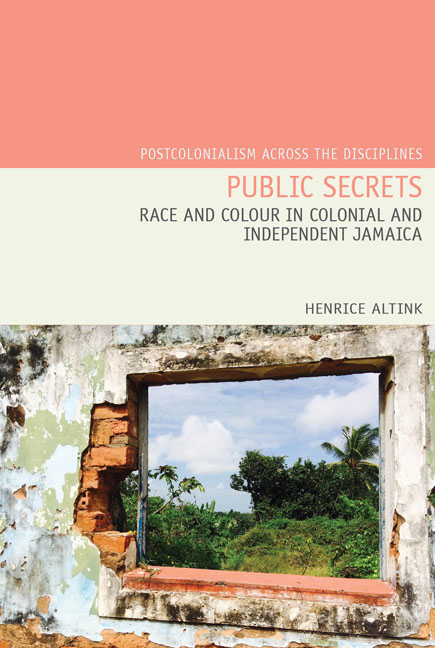Book contents
Introduction
Summary
Reflecting on his childhood in Jamaica in the 1930s and 1940s, the cultural theorist Stuart Hall remarked that ‘skin colour was, absolutely, an issue. But although everyone perfectly well understood what “black” meant, the very word was taboo, unsayable … It betrayed the prevailing prejudices too openly. Race depended on a more euphemistic, coded discourse’. Hall suggested, in other words, that in Jamaica race and colour ‘prejudices’ were what the anthropologist Michael T. Taussig has called a ‘public secret’ – something that is commonly known but which for one reason or another cannot easily be acknowledged. By examining a wide range of practices that firmly placed black people at the bottom of the social ladder and white and light-skinned people on top, this book will shed light on the public secret of race and colour in colonial and independent Jamaica. It examines different forms of white-on-black discrimination (overt, covert, individual, and institutional) and also colourism (or ‘shadism’ as it was locally known) – differential treatment according to skin tone. In addition to these forms of discrimination, the book explores practices which were devoid of racial content but equally helped to sustain a society stratified by race and colour, such as voting qualifications and entry criteria for elite secondary schools.
But this book is not just concerned to show the extent to which race and colour shaped social relations in colonial and independent Jamaica. It will also explore how the discriminatory and race-neutral practices and resulting racial disparities were able to remain a public secret, even though at times various groups and individuals, including the Universal Negro Improvement Association (UNIA), Rastafarians, and the Black Power movement spoke out about white-on-black discrimination or colourism. To do so, it examines various strategies used to talk about race, ranging from denial and minimisation to using ‘more euphemistic, coded discourse’, and also assesses what happened to those Jamaicans who transgressed the unwritten rule not to talk about race hinted at by Hall. One strategy increasingly used after the Second World War to keep race a public secret was the branding of the island as a racial paradise. One journalist, for instance, described Jamaica in 1951 as ‘the world's shop-window for racial equality’.
- Type
- Chapter
- Information
- Public SecretsRace and Colour in Colonial and Independent Jamaica, pp. 1 - 20Publisher: Liverpool University PressPrint publication year: 2019



